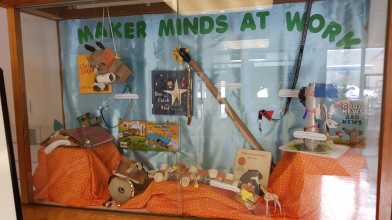The Maker Mind at Peaslee School
Guest Blogger: Nancy Kellner

One of the goals of both library and technology instruction at Peaslee School is to integrate seamlessly into the classroom curriculum. A recent Professional Development workshop was devoted to looking at the existing curriculum through the Maker Mindset.
Whether we are talking about how we are teaching and learning, what we are teaching and learning or where we are teaching and learning, it can be summed up with one concept—the Maker Mind. While this terminology might be new, the pedagogy isn’t really. Kindergarteners build sets out of blocks for their dramatic play, third graders create terrariums during a plant unit and fourth graders invent musical instruments while studying sound.
Hands-on learning has been around since the first youth apprenticed to a master crafter. What the maker mindset does is to encourage educators to view the entire curriculum through a new lens. Makers solve problems. Makers create. Makers think. Makers invent. Makers share.
One way of looking at this shift is to consider the following. Instead of asking students what they want to be when they grow up, ask them what problems they want to solve. This is what 21st century learning is all about–collaboration, creativity, communication, critical thinking and citizenship.

At a recent Professional Development day at Peaslee School, teachers had the opportunity to activate their maker minds in the area of language arts. Based on an approach developed at Tufts Center for Engineering Education and Outreach entitled Novel Engineering, teachers (in the role of students) teamed up to read picture books, identify problems faced by the characters, brainstorm solutions and then design prototypes (using low-tech materials such as duct tape, corrugated cardboard, paper towel tubes and pipe cleaners) to solve the problems. The books chosen were:
- I Want My Hat Back by Jon Klassen
- Good News Bad News by Jeff Mack
- How to Catch a Star by Oliver Jeffers
- Chu’s Day by Neil Gaiman
- The Little Engine That Could by Watty Piper
As professional development this activity served two purposes. The first–to inspire teachers to bring a similar lesson to their language arts instruction. The second–to empower teachers to continue to look for opportunities to incorporate STEAM education into their instructional units. Oh, and there was a third as well, if truth be told. We all had a boatload of fun!
